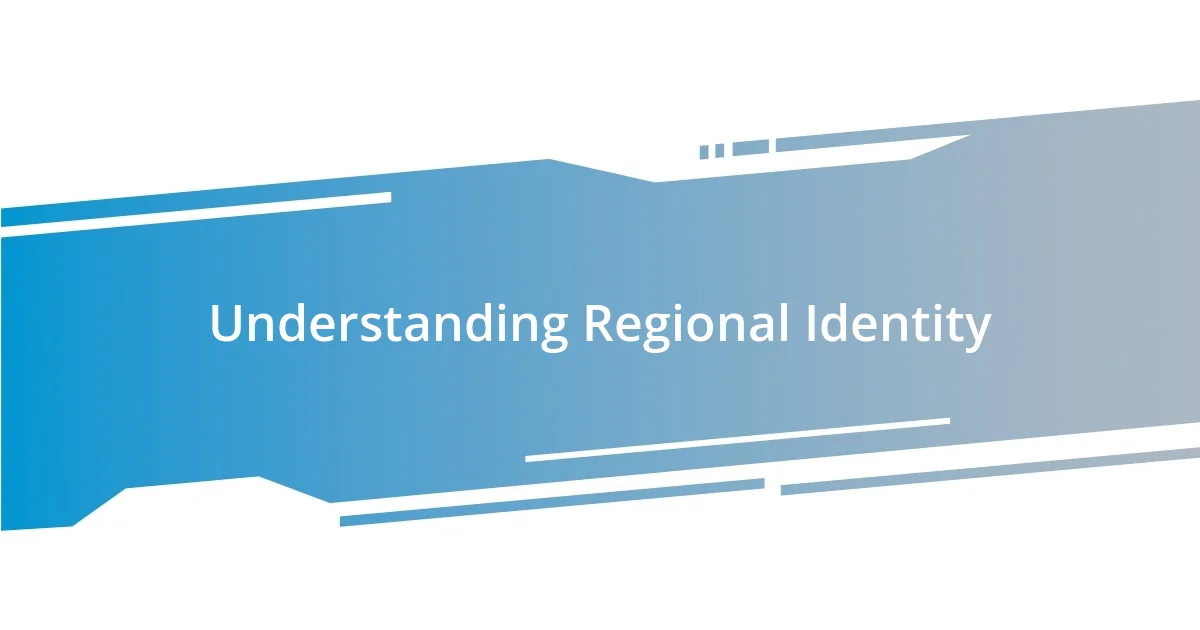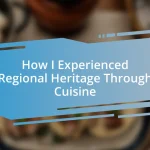Key takeaways:
- The exploration of regional identity is shaped by shared experiences, cultural narratives, and personal connections to one’s roots, as demonstrated by the author’s nostalgic return to their hometown.
- Diving into family history through genealogy reveals vital connections and stories that deepen one’s understanding of identity, bridging the past with the present.
- Engaging with local communities and traditions fosters a sense of belonging and unity, enhancing the emotional ties to heritage and creating collective memories.

Understanding Regional Identity
Understanding regional identity goes beyond geography; it’s deeply tied to shared experiences and cultural narratives. I recall going back to my hometown during a festival that had been celebrated for generations. The sights and sounds transported me back to my childhood, reminding me how pivotal those moments were in shaping my sense of belonging.
Have you ever felt that rush of nostalgia when you revisit familiar places? I remember standing in front of an old community center, a hub for countless gatherings in my youth. It struck me how this space held the stories and memories of so many, weaving a fabric of connection that transcends time and personal experiences.
Regional identity is a tapestry created from the myriad threads of language, traditions, and history we inherit. While walking through the market one sunny afternoon, I listened to conversations in our local dialect and felt an overwhelming sense of pride. It was a beautiful reminder that identity evolves as we engage with our roots, celebrating both individuality and the collective experience of those who came before us.

Exploring Family History Resources
Exploring my family history opened up a treasure trove of stories and connections. I remember spending hours sifting through old photographs, each one telling a tale of resilience and hope. In one photo, I caught a glimpse of my grandmother at a family reunion, radiant and surrounded by loved ones. It struck me how those faces, now faded with time, held pieces of my own identity.
As I dove deeper into genealogy, I discovered various resources that enriched my search. Local archives and online databases became my companions, revealing vital records like birth certificates and marriage licenses. I even found a distant cousin who had meticulously pieced together our family tree, leading me to places I never thought I’d explore. Suddenly, names on a page transformed into living stories.
The journey of connecting with my roots has been both enlightening and emotional. Visiting old cemeteries, I felt a connection with those who paved the way for me. It was almost surreal standing in front of gravestones with my family’s last name, imagining their lives and struggles. These historical sites became a bridge, linking me to my past in a way that made every step feel significant.
| Resource Type | Description |
|---|---|
| Local Archives | Repositories containing historical records, photos, and documents specific to your region. |
| Online Genealogy Websites | Platforms that offer access to public records, family trees, and DNA testing services to trace lineage. |
| Historical Societies | Organizations dedicated to preserving local history and often providing access to unique resources. |

Engaging with Local Communities

Engaging with Local Communities
Engaging with local communities is where my journey back to my roots truly flourished. I vividly recall attending a farmers’ market, where the vibrant stalls were bursting with fresh produce and handmade goods. The laughter and chatter of neighbors created a familiar atmosphere, a reminder that each face had a living story woven into the fabric of our shared community. It was in these moments that I felt the heart of my region—an energy that was both comforting and invigorating.
- Conversations with farmers revealed age-old techniques passed down through generations.
- I joined a local book club, uncovering not just literature but also the unique perspectives of fellow readers rooted in the same soil.
- Volunteering at community events enabled me to build relationships that transformed mere acquaintances into friends, deepening my connection to our heritage.
- Participating in cultural workshops offered me hands-on experiences that honored our traditions, making history tangible.
One of my favorite experiences was participating in a neighborhood cleanup. As we gathered, I was struck by the diverse backgrounds of the volunteers—people who, like me, were searching for a tangible way to connect with the land we called home. Digging through old debris, we uncovered small mementos that sparked stories among us, from childhood games played in those parks to dreams of revitalizing the space for future generations. Those simple moments united us, reminding me that engaging with local communities is more than just participation; it’s about creating a collective memory that honors our past while nurturing our future.

Celebrating Regional Traditions
Celebrating regional traditions has always been a heartfelt way for me to remain connected to my roots. I remember attending a local festival where everyone came together to showcase traditional crafts and foods. The air was filled with the aroma of homemade dishes, each representing a piece of our shared history. I couldn’t help but wonder how many recipes had been passed down through generations, carrying the essence of our culture.
At one booth, I participated in a folk dance workshop. As we learned the steps, laughter echoed around us, and I felt an incredible sense of belonging. The instructors shared stories about the origins of each dance, and I realized that these movements were more than just steps; they were expressions of our ancestors’ joys and struggles. It’s moments like these that remind me how traditions weave us together, creating a vibrant tapestry of shared experience.
Of all the traditions I celebrate, the seasonal harvest festival holds a special place in my heart. I recall guiding my children through the maze of pumpkins, chatting with neighbors about the best ways to prepare the season’s bounty. It dawned on me that these gatherings weren’t just about enjoying food or having fun—they were about honoring the cycles of nature and fostering community spirit. How often do we take the time to reflect on what these rituals mean? In moments of celebration, I feel anchored to my roots, and it fills me with gratitude for the path that has led us here.

Documenting Personal Experiences
Documenting personal experiences is a treasure trove of reflections that can reveal the deep connections we have with our roots. I’ve found that keeping a journal is an incredibly powerful way to capture these moments. One evening, I sat under the stars, scribbling down the laughter of children playing in the fields nearby and the glow of fireflies lighting up the night. Those words turned into snapshots of my nostalgia, letting me revisit those feelings whenever I choose.
During my latest visit to my childhood town, I took photos of familiar landmarks—each image carrying a unique tale. Standing outside my old school, I felt the rush of memories flooding back; it was as if the walls were whispering stories of friendships and dreams. Isn’t it amazing how a simple picture can evoke such strong emotions? Documenting these experiences, whether through writing or photography, helps preserve the essence of who we are and where we come from.
Engaging in the practice of storytelling within my family has also brought me closer to my heritage. At family gatherings, I often encourage my relatives to share their favorite memories, and the room fills with warmth and laughter. I remember my grandmother recounting tales of her childhood—her adventures wandering through the same woods I now roam. Listening to her stories not only fosters deeper connections but also enriches my understanding of our collective history. How often do we overlook the importance of sharing our stories? It’s through these exchanges that I’ve realized the threads that bind us are woven from shared experiences, creating a rich tapestry of our regional identity.

Sharing Stories with Others
Sharing stories with others is like giving a piece of myself to the people around me. I recall a heartwarming evening where my friends and I sat around a bonfire, swapping tales of our childhood adventures. As each story unfolded, I noticed how our laughter mingled with the crackling of the fire, creating a sense of unity. Isn’t it incredible how a simple story can spark connections and make us feel less alone?
One of my most cherished moments happened during a community potluck. I took a deep breath and shared my mother’s recipe for her famous cornbread, woven with memories of Sunday dinners filled with joy and loud voices. As I spoke, I could see nods of recognition and smiles from others who had similar dishes in their families. It affirmed for me that food isn’t just about nourishment; it carries history and tradition that bind us together. Isn’t it fascinating how sharing culinary stories can bridge generational gaps?
The power of storytelling is amplified when it involves younger generations. At a family reunion, I encouraged the kids to share their favorite stories about their grandparents. With wide eyes, they recounted funny incidents that had us all doubled over with laughter. In those moments, I realized how storytelling isn’t just an act of sharing; it’s an opportunity for teaching and preserving our heritage. How do we make sure these stories are passed on? By cherishing and amplifying them, we ensure that our roots remain alive, enriching the lives of those who come after us.

Building a Connection to Place
Building a connection to the place where I grew up has been an unexpected journey for me. I often wander through the familiar streets of my neighborhood, where every corner has a story to tell. Just last week, I found myself standing in front of an old oak tree that I climbed as a child. The rough bark felt the same under my fingers, and I couldn’t help but smile at the thought of summer afternoons spent balancing on its branches, lost in the carefree world of imagination. How can one tree hold so many memories?
I’ve also discovered that engaging with local traditions has deepened my ties to my hometown. During a recent festival, I participated in the ancient dance that my ancestors performed. The rhythm of the drums resonated within me, almost as if it was a heartbeat shared across generations. I remember looking around and seeing friends and strangers alike joining in, our collective joy creating an unspoken bond. Isn’t it beautiful how culture can bring people together in such a profound way?
Another layer of connection stems from exploring the natural landscape surrounding my home. There’s a small creek where I spent countless afternoons skipping stones and daydreaming. Recently, on a solitary walk, I paused to listen to the gentle trickle of water and the rustling leaves. It brought back the pure bliss of those childhood moments. Isn’t it remarkable how nature can ground us, reminding us of who we are and where we belong? Engaging with these familiar sights and sounds reinforces the love I have for my place—it’s like returning to a long-lost friend.














